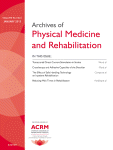
PHYSICAL THERAPY & REHAB
Home-based functional exercises improve disability, kinesiophobia, and pain in TKA patient
This report has been verified
by one or more authors of the
original publication.
Arch Phys Med Rehabil. 2013 Feb;94(2):231-9. doi: 10.1016/j.apmr.2012.10.003. Epub 2012 Oct 12
110 patients with knee osteoarthritis (OA) who underwent total knee arthroplasty (TKA) were randomised to either follow a functional exercise-based rehabilitation program and to read a home-exercise book, or to be given advice to stay active after being released from hospital. Functional improvements of each group were assessed over a 12 month period. The results displayed that the group who completed the exercise-based rehabilitation program and read a home-exercise book on how to manage kinesiophobia experienced better improvements in disability, kinesiophobia, pain, and quality of life (QOL).
Unlock the full ACE Report
You have access to {0} free articles per month.Click below to unlock and view this {1}
Unlock NowCritical appraisals of the latest, high-impact randomized controlled trials and systematic reviews in orthopaedics
Access to OrthoEvidence podcast content, including collaborations with the Journal of Bone and Joint Surgery, interviews with internationally recognized surgeons, and roundtable discussions on orthopaedic news and topics
Subscription to The Pulse, a twice-weekly evidence-based newsletter designed to help you make better clinical decisions
Exclusive access to original content articles, including in-house systematic reviews, and articles on health research methods and hot orthopaedic topics
Or upgrade today and gain access to all OrthoEvidence content for just $1.99 per week.
Already have an account? Log in


Subscribe to "The Pulse"
Evidence-Based Orthopaedics direct to your inbox.
{0} of {1} free articles
Become an OrthoEvidence Premium Member. Expand your perspective with high-quality evidence.
Upgrade Now













































































